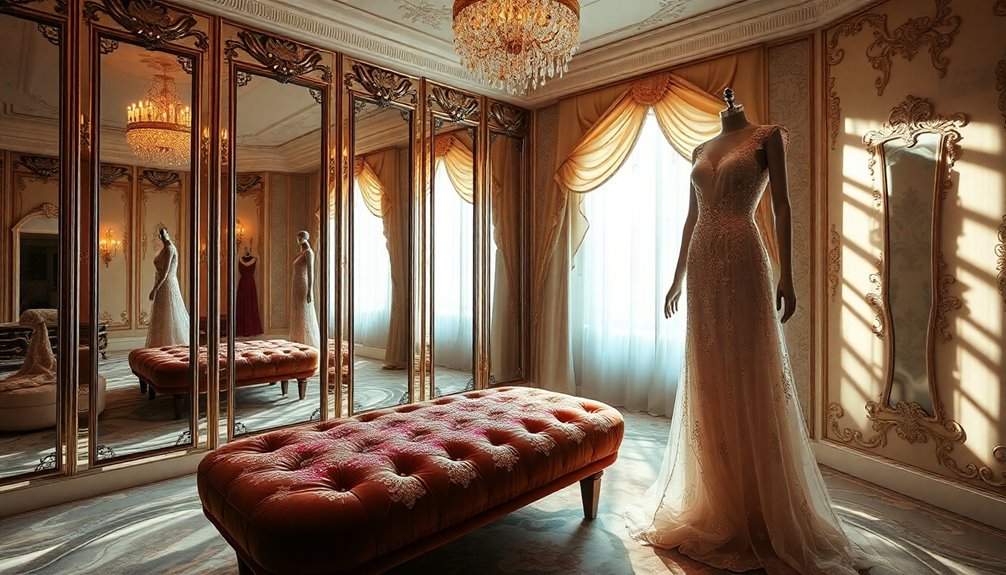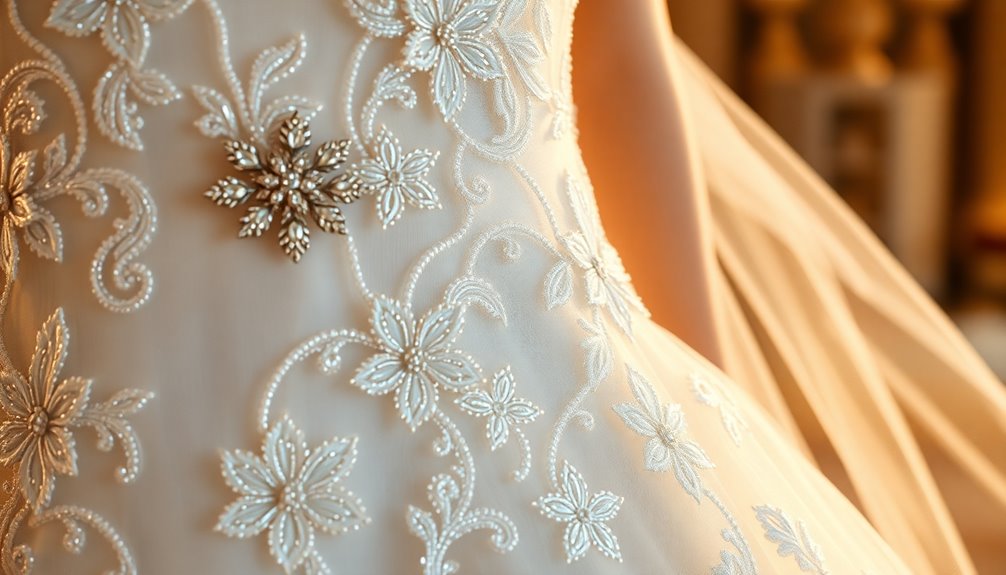Luxury handbags are smart investment pieces that combine timeless style with strong resale potential. Recognizable brands like Hermès, Chanel, and Louis Vuitton, especially limited editions and classic designs, tend to appreciate over time and hold or grow in value. Authenticity, quality, and proper maintenance are essential for maximizing resale. If you want to discover how to build a profitable, timeless collection and stay ahead of market trends, there’s more to explore here.
Key Takeaways
- Iconic, timeless designs like Hermès Birkin and Chanel Classic Flap often appreciate in value and are prime investment pieces.
- Limited editions and collaborations significantly boost resale value due to scarcity and exclusivity.
- Authenticity, proper maintenance, and original packaging are crucial for preserving long-term investment worth.
- Recognizable brand elements such as logos, monograms, and signature hardware enhance desirability and resale potential.
- Choosing durable, ethically sourced pieces aligned with sustainability trends maximizes future value and collection sustainability.
Why Luxury Handbags Make Smart Investment Assets
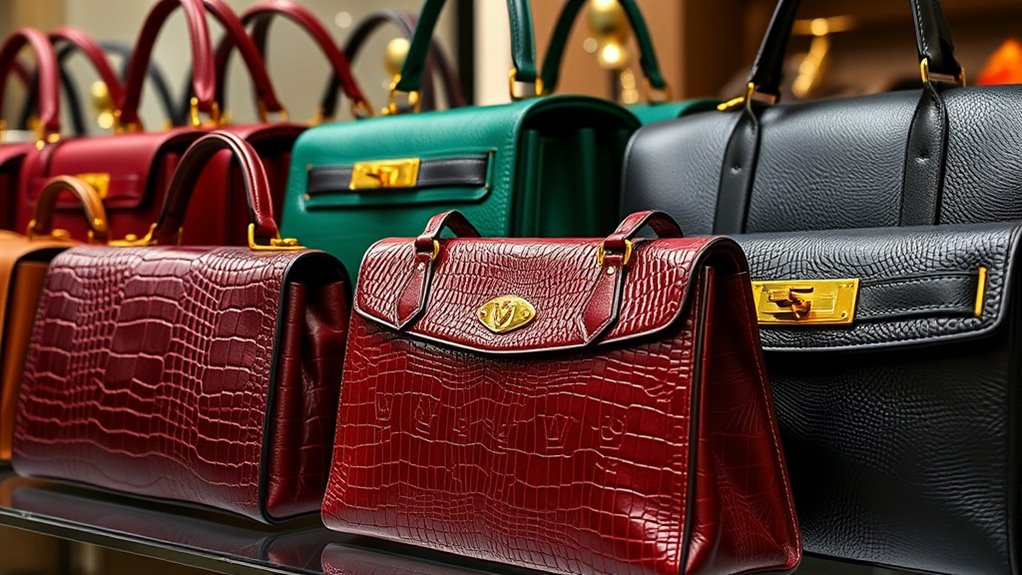
Luxury handbags from brands like Hermès, Chanel, and Louis Vuitton are more than just fashionable accessories—they’re smart investment assets. Their value often appreciates over time, making them a savvy choice for collectors. Handbags with iconic styles and limited editions tend to have strong resale potential, sometimes surpassing traditional investments like gold or stocks. High-quality craftsmanship and premium materials guarantee durability and lasting beauty, which are essential for maintaining their worth. Classic, seasonless designs tend to retain or grow in value, offering long-term financial benefits. When you invest in luxury bags, you’re acquiring tangible assets that blend aesthetic appeal with potential appreciation. Additionally, the collectibility of limited editions can significantly boost a handbag’s value over time. These handbags are more than accessories—they’re valuable assets that can enhance your portfolio and elevate your collection. Understanding brand reputation and market trends can help optimize your investment strategy for these luxury items. Moreover, staying informed about regulatory changes in the luxury market can help safeguard your investments and ensure you make well-informed purchasing decisions. Regularly monitoring market fluctuations can also provide insights into the best times to buy or sell.
Recognizing Top Resale Brands and Models
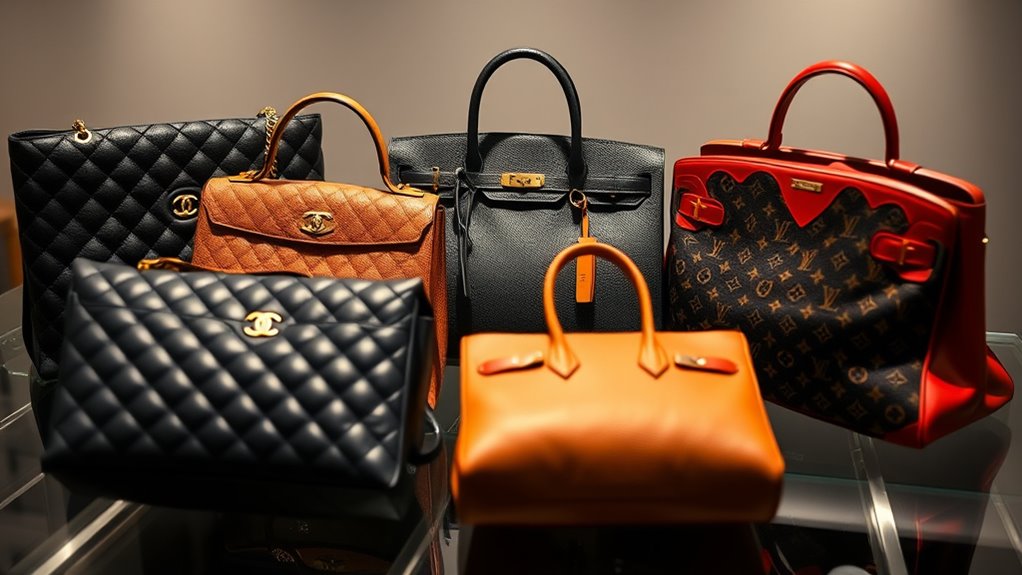
Knowing which brands and models hold their value is essential when investing in designer handbags. The Hermès Birkin is a top resale brand, often appreciating over 100% and selling for over $400,000 on secondary markets, making it a prime investment piece. Similarly, the Chanel Classic Flap retains about 120% of its original value, with vintage pieces increasing markedly over time. Louis Vuitton’s Capucines and Neverfull models are consistently sought after, maintaining strong resale values thanks to their craftsmanship and prestige. Other models, like the Gucci Jackie 1961 Bag, have seen demand rise by 20-50% annually since 2020, while Bottega Veneta’s Andiamo has doubled in resale value. Recognizing these brands and models helps you identify designer handbags with the best investment potential. Additionally, understanding the traits of successful investors can enhance your approach to luxury handbag investments by emphasizing patience and market awareness.
Essential Factors That Influence Resale Values

Your handbag’s resale value is heavily influenced by its iconic brand elements, like recognizable logos and monogramming, which boost its appeal. Limited editions and collectible styles also command higher prices because they’re rarer and more sought after. Recognizable design features and good condition further enhance a bag’s investment potential. A lightweight and durable construction can also play a role in maintaining value over time. Embracing a growth mindset can help collectors appreciate the evolving value of their pieces over time. Additionally, understanding brand heritage can deepen appreciation and guide smarter investment choices. Staying informed about authenticity verification methods ensures that collectors maintain their bags’ value and avoid counterfeit items.
Iconic Brand Elements
Have you ever noticed how certain handbags instantly catch your eye? It’s often due to iconic brand elements that define their identity. These features include:
- Logo hardware that boldly displays the brand’s emblem.
- Signature patterns like Louis Vuitton’s Damier or Gucci’s GG that are instantly recognizable.
- Timeless features such as Chanel’s quilting or Hermès’ saddle stitching that never go out of style.
- Design details that serve as brand signifiers, reinforcing the handbag’s exclusivity and heritage.
- The brand’s reputation and historical significance play crucial roles in shaping perceived value and desirability. When a bag features these signature patterns and design details, it’s perceived as an authentic piece with lasting appeal. They’re not just accessories—they’re investments rooted in their iconic brand signifiers.
Collectible and Limited Editions
Ever wondered why limited edition and collectible handbags often fetch such high resale prices? It’s because limited editions and collectible bags thrive on scarcity and exclusivity. When a bag is part of a limited production run or collaboration, its resale value skyrockets—selling at 150-200% of retail. Iconic or historically significant pieces, like vintage Chanel classics or Hermès Kelly models, tend to appreciate over time, making them prime investment pieces. Unique features such as rare hardware, special materials, or seasonal colorways further boost their desirability. Limited editions, especially anniversary or seasonal releases, are harder to find, increasing their appeal among collectors. This rarity and cultural importance drive demand, resulting in faster sales and higher resale values—perfect for building a valuable handbag collection. Incorporate vintage decor and natural materials to enhance the overall aesthetic and desirability of collectible handbags. Additionally, understanding the market trends and staying informed about upcoming releases can help collectors maximize their investment potential. Recognizing collectibility factors such as provenance and condition can further influence resale value and desirability.
Iconic Bags With Proven Market Performance
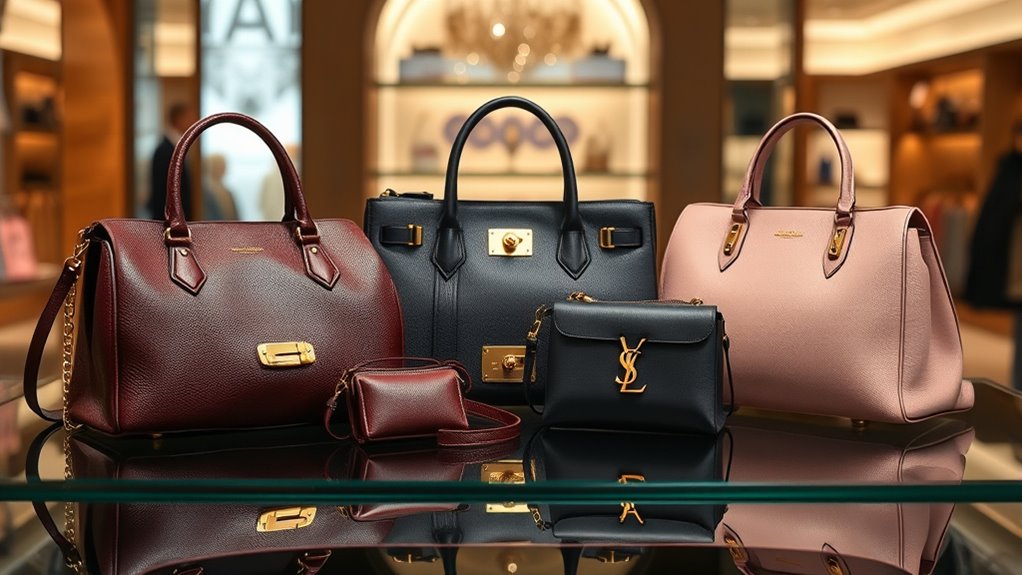
Iconic luxury handbags have consistently proven their market strength, often outperforming other investments. These market performance champions include:
Iconic luxury handbags consistently outperform other investments, showcasing remarkable market strength and enduring desirability.
- The Hermès Birkin 35, with a resale value increase of around 250% since 2023, making it an exceptional investment handbag.
- Chanel’s Classic Flap bags, especially in caviar leather, holding about 100% of their retail value, with vintage models like the Turnlock small flap reaching $4,480.
- The Gucci Jackie 1961 Bag, whose resale prices have grown 20-50% annually since 2020, now valued at approximately $3,800.
- The Bottega Veneta Andiamo Bag, doubling in resale value since 2020, with prices around $4,800 to $5,500.
Limited edition and vintage bags, like the Dior Saddle, continue to appreciate and retain immense desirability. Understanding market trends can help collectors make informed decisions when investing in luxury handbags.
How to Identify Timeless, Investment-Worthy Designs

When choosing a timeless handbag, look for classic styles like the Chanel Flap, Hermès Birkin, or Louis Vuitton Capucines that resist seasonal trends. Recognizable brand signifiers and heritage details add long-term value and appeal. Opt for versatile shapes, neutral colors, and high-quality materials to guarantee your investment stays stylish for years to come. Additionally, selecting handbags made from sustainable materials ensures both durability and eco-consciousness, aligning with modern values. Incorporating ethical sourcing and environmentally responsible manufacturing practices further enhances the handbag’s meaningfulness as an investment piece. Understanding ethical hacking principles can also inspire a thoughtful approach to valuing authenticity and security in your collection. Embracing timeless design ensures your collection remains relevant beyond fleeting fashion trends.
Classic Styles That Endure
Identifying timeless, investment-worthy handbags involves recognizing designs that have stood the test of time and continue to appeal across seasons. Classic silhouettes like the Chanel Flap, Hermès Birkin, and Louis Vuitton Capucines exemplify this. These styles feature seasonless designs, versatile colors such as black, beige, or navy, and high-quality materials like calfskin, exotic leathers, or signature canvas. Visualize a sleek, structured Chanel Flap resting comfortably on your shoulder, or an Hermès Birkin’s elegant shape in luxurious leather. Recognizable brand elements, including logo hardware and monogramming, reinforce their iconic status. The most enduring styles balance fashion longevity, functionality, and subtle branding, ensuring they remain relevant and valuable as collectible bags for generations to come. Additionally, understanding self-watering plant pots can inspire durable and low-maintenance display pieces or gift options for plant-loving collectors. Cultivating an awareness of cultural intelligence can also influence how you navigate different markets and consumer preferences when investing in luxury items globally. Moreover, being familiar with butter varieties and their unique qualities can help collectors appreciate the craftsmanship behind luxury accessories, as both require careful selection and expert handling to maintain their value.
Recognizable Brand Signifiers
Recognizable brand signifiers serve as visual cues that instantly authenticate and elevate the desirability of a handbag. Logo hardware, such as the Chanel CC turnlock or Hermès palladium hardware, are iconic hardware pieces that signal a bag’s heritage and craftsmanship. Signature motifs, like Louis Vuitton’s monogram canvas or Bottega Veneta’s woven leather, act as key brand elements that distinguish timeless designs. Subtle branding, such as discreet logos or minimal hardware, often indicates investment-worthy pieces that remain stylish across seasons. Limited edition details, unique materials, and collectible features further enhance a bag’s value. By recognizing these brand signifiers, you can identify handbags with lasting appeal and potential for long-term investment, ensuring your collection stays both stylish and valuable over time. Additionally, understanding timeless design elements can help you select pieces that maintain relevance and desirability through changing fashion trends. Recognizing brand heritage traits can also provide insight into a bag’s historical significance and craftsmanship quality.
The Role of Rarity and Limited Editions in Value Growth
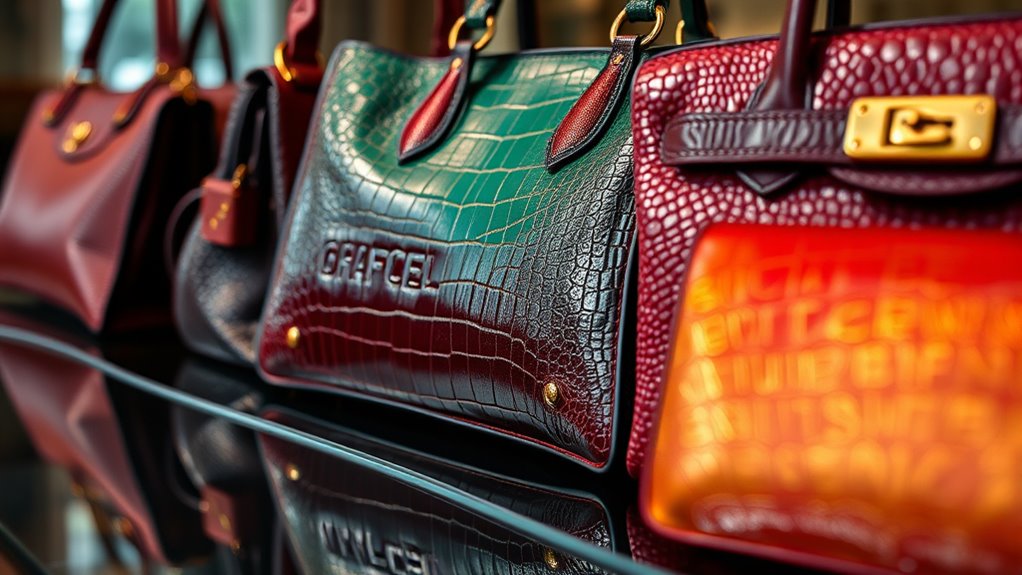
Rarity and limited editions play a crucial role in driving the value growth of luxury handbags. When you invest in limited editions, their scarcity elevates their desirability and resale value. Imagine owning a bag with:
- Unique collaborations that stand out from regular releases
- Limited production runs, like Hermès Birkins in rare leathers or colors
- Special design elements that make each piece collectible
- Anniversary or artist-inspired collections that boost exclusivity
These factors create a sense of scarcity, making the handbag more than just fashion—it’s an investment. The exclusivity and limited availability often lead to prices soaring 50-200% above retail, positioning these bags as highly sought-after collectible pieces with significant growth potential.
Best Practices for Authenticating and Maintaining Your Collection
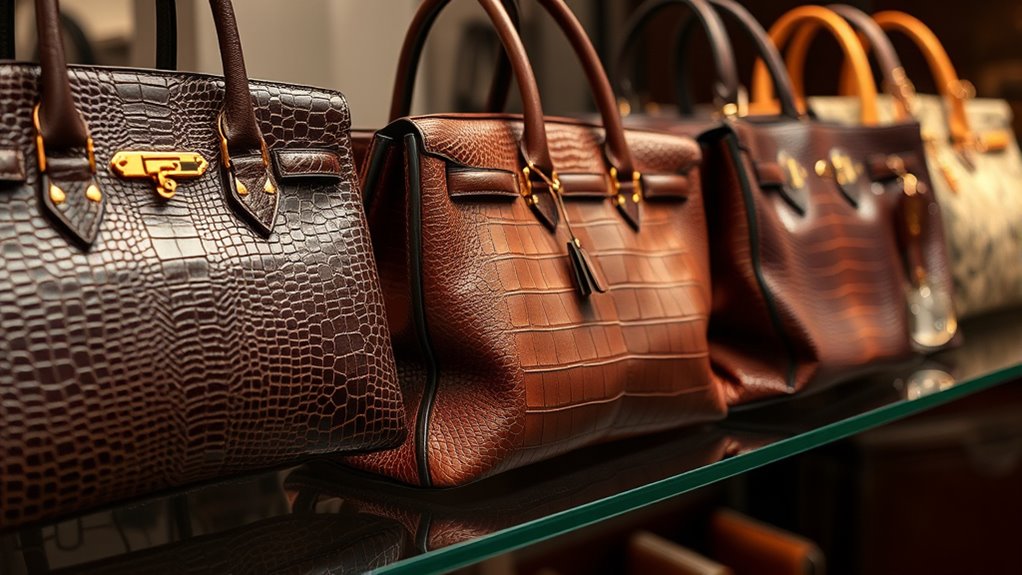
Protecting the value of your luxury handbag collection requires careful attention to authenticity and proper maintenance. To verify authenticity, examine stitching quality, serial numbers, and hologram tags, and compare them with official brand databases. Inspect materials like leather and hardware for consistency, scent, and texture, which reflect genuine craftsmanship. Keep all original cards, dust bags, and packaging intact, as these boost resale value and authenticate your pieces. Regularly clean and professionally maintain your handbags to prevent damage and preserve their physical and monetary worth. Store your bags in a cool, dry place, away from sunlight and humidity, using dust bags or protective boxes. These best practices ensure your collection stays authentic, well-preserved, and valuable for years to come.
Strategies for Building a Diversified and Profitable Bag Portfolio
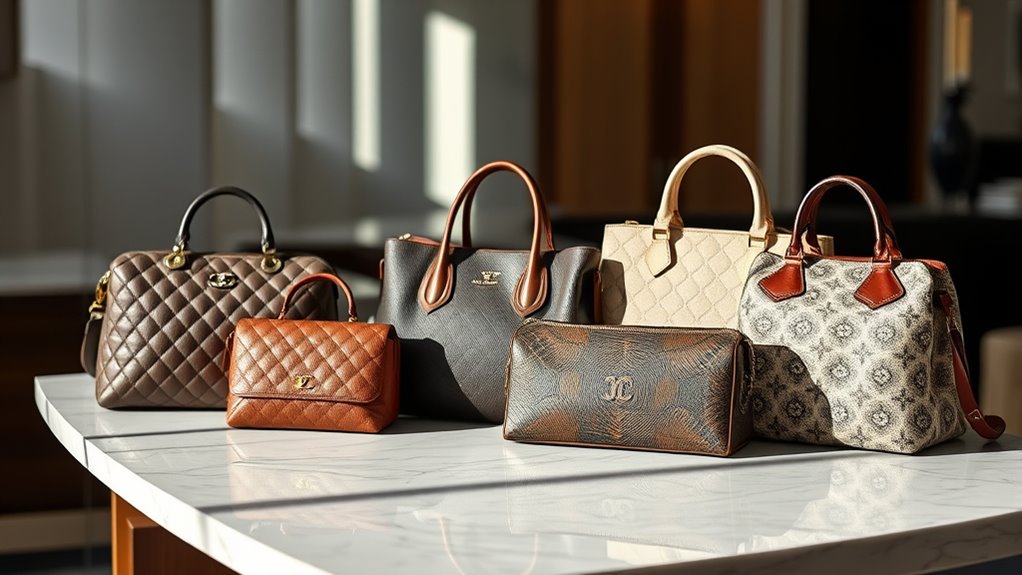
Building a profitable bag portfolio starts with focusing on timeless designs like the Hermès Birkin and Chanel Classic Flap, which hold or grow their value over time. You should also balance your collection by including emerging brands such as Toteme and Savette to capture new market opportunities. By carefully selecting a mix of brands and styles, you can maximize both diversification and long-term gains.
Focus on Classic Designs
Focusing on classic designs is essential for creating a stable and profitable luxury handbag collection. These timeless classics serve as investment pieces that consistently hold or increase their resale value. Imagine owning:
- A sleek Chanel Classic Flap, its iconic silhouette always in demand.
- An Hermès Birkin, a heritage style that symbolizes exclusivity.
- A Louis Vuitton Capucines, blending heritage with modern appeal.
- A simple yet elegant Dior Saddle, a sought-after limited-edition model.
Balance Brands and Styles
Creating a versatile handbag collection requires more than just selecting timeless designs; it involves strategically balancing brands and styles to maximize profitability and reduce risk. By diversifying across luxury brands like Hermès, Chanel, and Louis Vuitton, you can better navigate market fluctuations and boost resale potential. Incorporate a mix of classic styles, such as the Chanel Flap or Hermès Birkin, with trending models like the Loewe Puzzle or Toteme T-Lock, to maintain timeless appeal while capturing current demand. Allocating funds to limited-edition or collectible bags can accelerate appreciation, enhancing your investment-grade pieces. Additionally, balancing different price points—from entry-level options to high-end investments—ensures flexibility. Regularly tracking market trends and resale data keeps your portfolio relevant, profitable, and aligned with evolving preferences.
Trends Shaping the Future of Luxury Handbag Investments
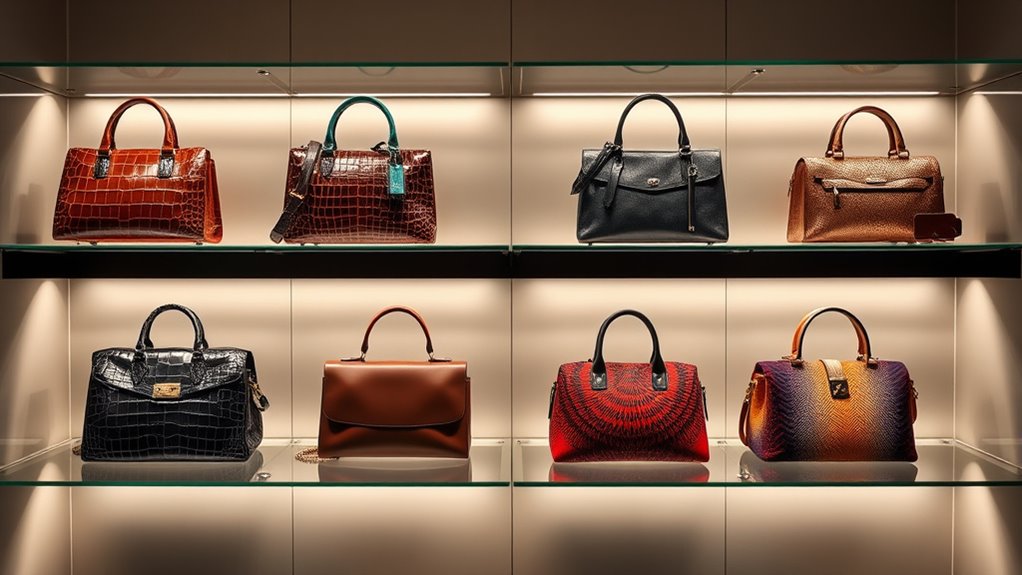
The future of luxury handbag investments is being shaped by a blend of timeless appeal and modern innovation. Resale markets are booming, driven by the resurgence of vintage brands like Chanel and Hermès, boosting market desirability and investment potential. Emerging brands such as Toteme and Savette are gaining traction through modern designs and rapid sell-through rates, reflecting shifting market trends. Limited edition releases, collaborations, and unique materials create collectible pieces that markedly enhance future value. Additionally, the emphasis on circular fashion and sustainability encourages investments in durable, high-quality handbags that retain or increase their worth over time. Visualize:
- Classic Hermès Birkin increasing in value.
- Fresh designs from emerging brands capturing attention.
- Limited edition handbags becoming highly sought-after collectibles.
- Sustainable handbags combining style with eco-consciousness.
Tips for Reselling and Maximizing Return on Investment
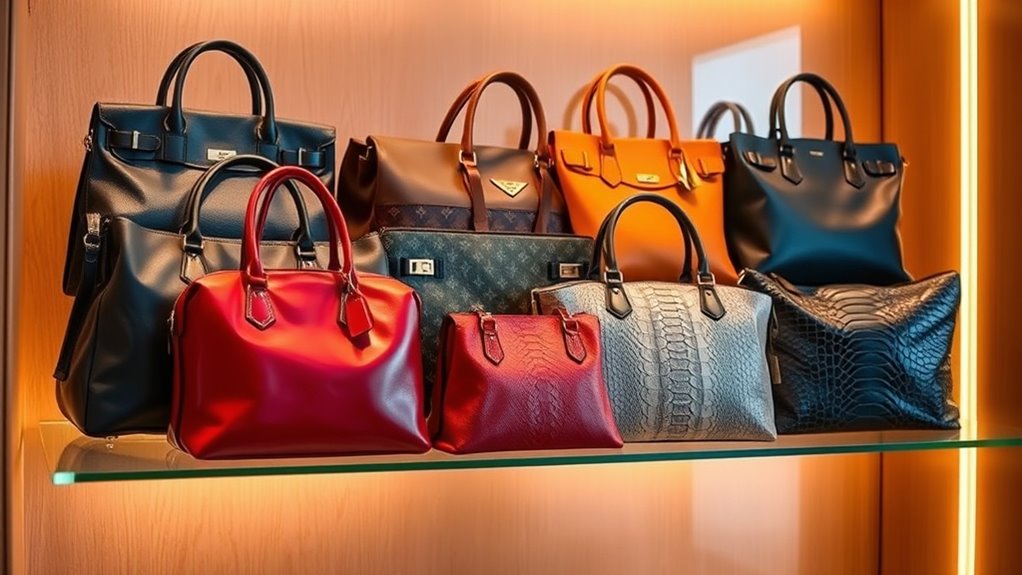
To maximize your resale value, you should prioritize maintaining your handbag’s original condition by storing it properly in dust bags and protecting it from sunlight and humidity. Regular professional cleaning and minor repairs help preserve its appearance and authenticity, leading to higher returns when reselling. Selling through reputable platforms like Rebag, The RealReal, or Fashionphile ensures authentic transactions and can boost resale prices. Timing your sale during peak demand seasons, such as spring or holidays, can also increase your handbag’s value. Keep all original packaging, authenticity cards, and receipts to enhance the perceived value and desirability of your secondhand pieces. By following these tips, you’ll optimize your investment and secure the best possible return on your luxury handbag.
Frequently Asked Questions
Which Luxury Bags Hold Value?
You want to know which luxury bags hold value, right? Hermès Birkin bags are top performers, often retaining up to 250% of their retail price and selling for around $25,000. Chanel Classic Flaps hold steady, usually at 100% of their original value. The Gucci Jackie 1961 and Bottega Veneta Andiamo have also gained value over time. Focus on limited editions and iconic styles for the best investment.
What Is the Holy Trinity of Luxury Bags?
Ever wondered what the ultimate luxury handbag trio is? The Holy Trinity includes Chanel, Hermès, and Louis Vuitton. You’ll find these brands renowned for craftsmanship, timeless design, and strong resale value. Hermès Birkin and Kelly bags often appreciate over 14% annually, while Chanel classics like the 2.55 hold about 120% of their original price. Collecting these pieces guarantees your investment remains both stylish and valuable over time.
What Is the Most Sought After Designer Bag?
You’re curious about the most sought-after designer bag, and the Hermès Birkin tops the list. Known for its exclusivity and craftsmanship, it often sells for up to $400,000 on the resale market. Its rarity and status symbol make it highly desirable among collectors and fashion enthusiasts alike. If you’re looking for a true investment piece, the Birkin’s reputation for holding and increasing value makes it the ultimate choice.
What Luxury Brand Holds the Most Value?
You ask which luxury brand holds the most value, as if it’s just about shiny objects. In reality, Hermès dominates resale values, with bags like the Birkin appreciating up to 127%. Chanel’s classics and Louis Vuitton’s popular prints also hold their worth well. So, if you’re after a true investment, Hermès’s exclusivity and craftsmanship make it the clear leader—your wallet will thank you.
Conclusion
By investing in luxury handbags, you’re not just adding to your collection—you’re building a treasure trove that could turn into a fortune. With the right choices, authenticating, and timing, your collection could outperform even the most legendary assets. Remember, this isn’t just about style; it’s about securing a legacy of elegance and value that’ll shine brighter than the stars. Plunge in confidently, and watch your collection transform into an unstoppable force of investment brilliance.



